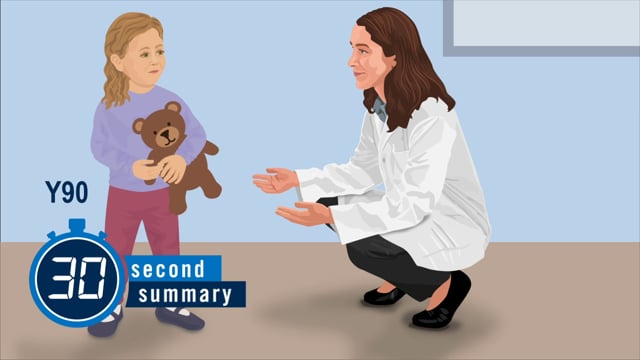Radioembolization (TARE-Y90) for Liver Tumors
What Is Radioembolization (TARE-Y90)?
Radioembolization (ray-dee-oh-em-beh-lih-ZAY-shun) is a procedure used to treat some kinds of liver tumors.
A specialized doctor, called an interventional radiologist, injects tiny beads containing radioactive material into a blood vessel that leads to the tumor. The radioactive material, yttrium-90 (Y90), works right on the tumor with minimal effect on the healthy tissues around it.
The full name of this treatment is transarterial radioembolization with yttrium-90 (TARE-Y90).

30-Second Summary: Radioembolization (TARE-Y90)
Learn the basics in 30 seconds.
Why Is Radioembolization Done?
Radioembolization can:
- Shrink a tumor so it is easier to remove.
- Kill cancer cells or slow cancer growth to give a child more time for a transplant organ to become available.
- Help make symptoms better.
Radioembolization goes through a blood vessel and right to the liver tumor. The radioactive material doesn't pass through healthy parts of the body to reach the cancer cells, as happens in other kinds of radiation treatments.
Sometimes doctors use radioembolization with other treatments, like chemotherapy and surgery.
What Happens Before Radioembolization?
The interventional radiologist will explain the risks and likely benefits of radioembolization. If you decide the procedure is right for your child, you'll be asked to sign a consent (permission) form. Then, you will schedule the procedure.
Before the procedure, the care team will let you know:
- if your child needs to stop any medicines
- when your child should stop eating and drinking
- whether your child will stay in the hospital or go home after the procedure
- how to care for your child after the procedure
How Is Radioembolization Done?
Your child will have the procedure in a room called an interventional radiology suite (IR suite). It's like an operating room with extra X-ray and ultrasound equipment. Besides the interventional radiologist, other professionals work as a team to help your child:
- an anesthesiologist
- nurses and assistants
- technologists (equipment specialists)
Before going into the IR suite, the care team will:
- Place an intravenous (IV) line in one of your child's veins (if a line is not already in place).
- Put medicine (anesthesia) into the IV so your child will fall asleep.
The anesthesiology team will bring your child to the IR suite. For most radioembolization procedures, the interventional radiologist will:
- Put a thin into your child's femoral artery, a large blood vessel near the groin (where the lower belly meets the upper thigh).
- Use X-ray images and videos to guide the catheter's tip to the blood vessels being treated.
Radioembolization requires at least two treatment sessions, separated by at least a week:
- The first part is a mapping angiogram (special X-ray) that gives a roadmap of the blood vessels in and around the liver. The doctor will inject a dye called as part of this mapping. They may also block off vessels to prevent radioactive particles from spreading to other parts of the body. A test will confirm there's no shunting of blood flow through the liver into the lungs.
- The second session is the injection of the radioactive particles/Y90 into the blood vessels supplying the tumor.
Can I Stay with My Child During Radioembolization?
You can stay with your child until it's time to go to the IR suite. Then, you'll move to the waiting area.
After the procedure, you'll go to the recovery room to be there as your child wakes up from the anesthesia. Because the Y90 isn't throughout the body, kids don't need to be isolated. They'll get regular nursing care as they recover.
How Long Does Radioembolization Take?
Each procedure (mapping angiogram and Y90 treatment) can take 2–5 hours. It depends on how many tumors are being treated and where they are.
What Happens After Radioembolization?
For a few days after the procedure, your child may have:
- groin pain or bruising
- tiredness (fatigue)
- a fever
- mild belly pain that could include nausea and vomiting
Because the radioactive beads stay deep inside the liver, little to no radiation leaves your child's body. Most of the radioactivity fades from the beads in 7–10 days. The radiation may keep working on the tumor(s) for several weeks to months. Doctors don't remove the beads unless the liver tumor is surgically removed or transplanted.
Are There Any Risks From Radioembolization?
Problems aren't common, but they can sometimes happen. They can include:
- infection, bleeding, or blood vessel damage at the site the catheter entered the groin
- damage to another part of the body (such as the lungs, stomach, intestine, or pancreas) if the radiation moves out of the targeted area
- liver or gallbladder problems
- an allergic reaction or kidney problem from the contrast dye used to see the blood vessels
- a lowered number of infection-fighting cells in the blood (leukopenia)
- a lowered number of blood clotting cells (platelets) (thrombocytopenia)
How Can Parents Help?
After your child gets home:
- Reassure and comfort your child until they feel better.
- Follow the instructions the interventional radiology team gives you.
When Should I Call the Doctor?
Call the doctor if your child has:
- swelling, redness, or bleeding in the groin
- pain that doesn't go away with pain medicine
- problems with the leg on the side that had the catheter. Watch for pain, numbness, tingling, a blue color, or a cold feeling.
- a fever higher than 100.4°F (38°C)
- belly pain or nausea that gets worse or is not getting better

© 1995- The Nemours Foundation. KidsHealth® is a registered trademark of The Nemours Foundation. All rights reserved.
Images sourced by The Nemours Foundation and Getty Images.













